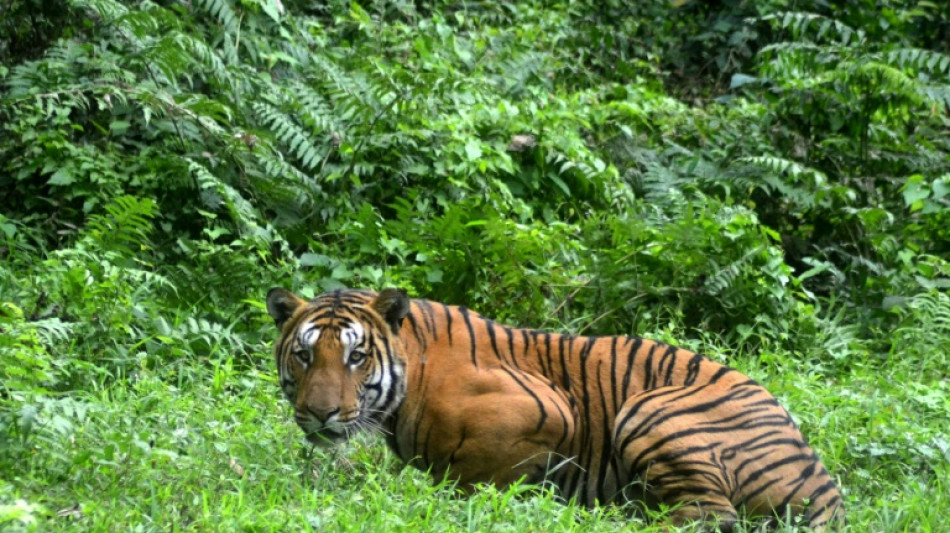
-
 Law and disorder as Thai police station comes under monkey attack
Law and disorder as Thai police station comes under monkey attack
-
Philippines cleans up as typhoon death toll rises

-
 Long delayed Ukrainian survival video game sequel set for release amid war
Long delayed Ukrainian survival video game sequel set for release amid war
-
Philippines cleans up after sixth major storm in weeks

-
 Markets swing after Wall St losses as traders weigh US rates outlook
Markets swing after Wall St losses as traders weigh US rates outlook
-
Gabon early results show voters back new constitution

-
 Is AI's meteoric rise beginning to slow?
Is AI's meteoric rise beginning to slow?
-
Biden touts climate legacy in landmark Amazon visit

-
 Biden clears Ukraine for long-range missile strikes inside Russia
Biden clears Ukraine for long-range missile strikes inside Russia
-
'Nobody can reverse' US progress on clean energy: Biden

-
 Biden allows Ukraine to strike Russia with long-range missiles: US official
Biden allows Ukraine to strike Russia with long-range missiles: US official
-
Biden clears Ukraine for missile strikes inside Russia

-
 Ukrainians brave arduous journeys to Russian-occupied homeland
Ukrainians brave arduous journeys to Russian-occupied homeland
-
'Devil is in the details,' EU chief says of S.America trade deal

-
 Toll in Tanzania building collapse rises to 13, survivors trapped
Toll in Tanzania building collapse rises to 13, survivors trapped
-
'Red One' tops N.America box office but could end up in the red

-
 Biden begins historic Amazon trip amid Trump climate fears
Biden begins historic Amazon trip amid Trump climate fears
-
Macron defends French farmers in talks with Argentina's Milei

-
 India and Nigeria renew ties as Modi visits
India and Nigeria renew ties as Modi visits
-
Typhoon Man-yi weakens as it crosses Philippines' main island

-
 迪拜棕榈岛索菲特美憬阁酒店: 五星級健康綠洲
迪拜棕榈岛索菲特美憬阁酒店: 五星級健康綠洲
-
The Retreat Palm Dubai MGallery by Sofitel: Пятизвездочный велнес-оазис

-
 The Retreat Palm Dubai MGallery by Sofitel: A five-star wellness Oasis
The Retreat Palm Dubai MGallery by Sofitel: A five-star wellness Oasis
-
Power cuts as Russian missiles pound Ukraine's energy grid

-
 Biden in historic Amazon trip as Trump return sparks climate fears
Biden in historic Amazon trip as Trump return sparks climate fears
-
India hails 'historic' hypersonic missile test flight

-
 Debt-saddled Laos struggles to tame rampant inflation
Debt-saddled Laos struggles to tame rampant inflation
-
India's vinyl revival finds its groove

-
 Climate finance can be hard sell, says aide to banks and PMs
Climate finance can be hard sell, says aide to banks and PMs
-
Egypt's middle class cuts costs as IMF-backed reforms take hold

-
 Dinosaur skeleton fetches 6 million euros in Paris sale
Dinosaur skeleton fetches 6 million euros in Paris sale
-
Trump's Republican allies tread lightly on Paris pact at COP29

-
 China's Xi urges APEC unity in face of 'protectionism'
China's Xi urges APEC unity in face of 'protectionism'
-
Farmers target PM Starmer in protest against new UK tax rules

-
 UN climate chief urges G20 to spur tense COP29 negotiations
UN climate chief urges G20 to spur tense COP29 negotiations
-
Philippines warns of 'potentially catastrophic' Super Typhoon Man-yi

-
 Tens of thousands flee as Super Typhoon Man-yi nears Philippines
Tens of thousands flee as Super Typhoon Man-yi nears Philippines
-
Gabon votes on new constitution hailed by junta as 'turning point'

-
 Tens of thousands flee as Typhoon Man-yi nears Philippines
Tens of thousands flee as Typhoon Man-yi nears Philippines
-
Is Argentina's Milei on brink of leaving Paris climate accord?

-
 Fitch upgrades Argentina debt rating amid economic pain
Fitch upgrades Argentina debt rating amid economic pain
-
Trump picks Doug Burgum as energy czar in new administration

-
 At summit under Trump shadow, Xi and Biden signal turbulence ahead
At summit under Trump shadow, Xi and Biden signal turbulence ahead
-
Xi warns against 'protectionism' at APEC summit under Trump cloud

-
 Xi, Biden at Asia-Pacific summit under Trump trade war cloud
Xi, Biden at Asia-Pacific summit under Trump trade war cloud
-
Leftist voices seek to be heard at Rio's G20 summit

-
 Boeing strike will hurt Ethiopian Airlines growth: CEO
Boeing strike will hurt Ethiopian Airlines growth: CEO
-
US retail sales lose steam in October after hurricanes

-
 Spate of child poisoning deaths sparks S.Africa xenophobia
Spate of child poisoning deaths sparks S.Africa xenophobia
-
Comedian Conan O'Brien to host Oscars


India's tiger population rises above 3,000
India's wild tiger population -- by far the largest in the world -- has risen above 3,000, according to a census released Sunday, boosting efforts to conserve the endangered species.
The largest of all cats, tigers once roamed throughout central, eastern and southern Asia.
But in the past 100 years the tiger has lost more than 93 per cent of its historic range and now only survives in scattered populations in 13 countries, according to the International Union for Conservation of Nature (IUCN).
The Indian census estimated there were 3,167 tigers in the wild across the country, up from 2,967 reported in the last such exercise.
Surveys are conducted every four years, using camera traps and computer programs to individually identify each creature.
The rate of increase has slowed to less than seven percent over the period, down from more than 30 percent in the previous four years.
But Prime Minister Narendra Modi said the new figure was a "proud moment".
"Our family is expanding," he said at a ceremony in the southern city of Mysuru. "This is a matter of pride not not only for India but the entire world."
Deforestation, poaching and human encroachment on habitats have devastated tiger populations across Asia but Modi said India had been able to increase its numbers thanks to "people's participation" and the country's "culture of conservation".
India is now home to 75 percent of the global tiger population and also the "largest tiger range country in the world", he added.
In 1900, more than 100,000 tigers were estimated to roam the planet. But that fell to a record low of 3,200 in 2010.
That year, India and 12 other countries with tiger populations signed an agreement to double their big cat numbers by 2022.
India is believed to have had a tiger population of around 40,000 at the time of independence from Britain in 1947.
That fell over subsequent decades to about 3,700 in 2002 and an all-time low of 1,411 four years later, but numbers have since risen steadily.
Dipankar Ghose, director of the wildlife and habitats programme at the World Wide Fund for Nature-India told AFP the latest increase in tiger numbers was encouraging.
"On the other hand it also tells us that each of us now need to work harder to restore degraded habitats, ensure safe movement of tigers through corridors and promote coexistence," he added.
C.Peyronnet--CPN


